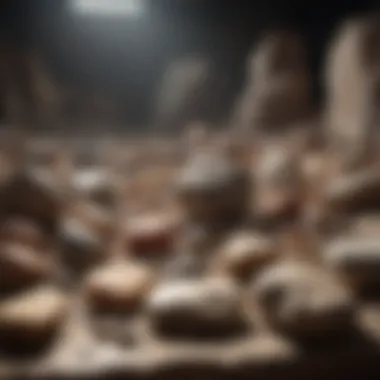Exploring the Aesthetic and Educational Value of Rock Displays


Intro
In the realm of geology, the allure of rock displays transcends mere scientific interest; it invites both curiosity and admiration. For collectors, enthusiasts, and educators alike, showcasing these natural treasures can be an art form, blending aesthetics and education into a seamless presentation. This guide digs into the art and science behind creating captivating rock displays. It is a journey into nuances—where your collection not only takes center stage but also tells a story that resonates with viewers.
Rock and Fossil Identification
Understanding the essence of your specimens starts with identification. Knowing what you possess can deeply influence how you display it. Identifying rocks and fossils helps collectors appreciate their journey—from formation in ancient environments to their place in modern displays.
Types of Rocks and Fossils
Rocks are generally categorized into three main types: igneous, sedimentary, and metamorphic. Each category brings unique features:
- Igneous rocks: Formed from cooled magma or lava; examples include basalt and granite.
- Sedimentary rocks: Created from accumulated sediment; look for sandstone and limestone.
- Metamorphic rocks: Transformed by heat and pressure, like marble and schist.
In terms of fossils, they can derive from diverse life forms, including:
- Body fossils: Physical remains like bones and shells.
- Trace fossils: Signs of life such as footprints or burrows.
- Microfossils: Tiny fossils that require a microscope for examination.
Characteristics to Look For
When identifying a specimen, pay close attention to its:
- Color: What is the dominant hue? Are there patterns?
- Texture: Is it smooth, rough, or layered? This often indicates its geological history.
- Weight: Heavier specimens might indicate a denser mineral composition.
Tools for Identification
Embracing technology or traditional tools can enhance your identification efforts:
- A hand lens enhances your ability to see fine details.
- Field guides or apps like Rock Identifier are invaluable.
- A geological hammer can help examine rock structures up close.
"Understanding your specimens isn't just the first step—it's the heart of crafting meaningful displays that speak to the viewer about time and the earth."
By mastering rock and fossil identification, you'll not only refine your collection but also elevate the stories that each piece tells. The next sections will dive into collecting tips, preservation methods, and creative display ideas to further enhance your rock display journey.
Preamble to Rock Displays
Rock displays play a pivotal role in showcasing the beauty and diversity of geological specimens. Whether exhibited in a personal collection, educational setting, or public museum, these displays embody a bridge between nature’s artistry and human curiosity. This section emphasizes the unique characteristics of rock displays that make them essential for both appreciation and education.
Defining Rock Displays
When we talk about rock displays, it isn’t just about arranging objects on a shelf. It encapsulates the thoughtful presentation of minerals, fossils, and gemstones, each with stories etched in their very formations. Picture a vibrant display of amethyst geodes next to rough-cut obsidian: such a setting does more than say, "Look at these rocks!" It invites viewers to explore colors, textures, and histories, igniting their imaginations and sparking questions. For many collectors, it becomes a way to express love for geology.
Historical Context
The practice of displaying rocks can be traced back centuries, with roots in scientific investigation and artistic endeavors. In ancient times, peculiar stones would catch the eye. They were integrated into cultural artifacts or revered as mystical objects. Fast forward to the Renaissance, where the fascination for natural history blossomed. Collectors such as Ulisse Aldrovandi, who meticulously cataloged specimens, set foundations for future generations.
As modern society evolved, so did our approach to displaying natural treasures. Museums began to curate exhibits, blending art and science, making geology accessible to the masses. Rock displays have since developed into an art form, merging aesthetics with education, allowing people from all walks of life to engage with the Earth’s story. Today, aspiring collectors and seasoned enthusiasts alike often take cues from this evolving narrative, blending centuries of knowledge with personal ingenuity in their displays.
The Purpose of Rock Displays
When it comes to showcasing rock collections, the purpose behind the displays holds significant weight. It’s not just about putting pretty stones on a shelf; it goes deeper, layering in aesthetics, education, and personal expression. Embracing these elements can elevate a collection to new heights, turning everyday rocks into conversation starters and teaching tools. Understanding why rock displays matter can inform how collectors choose to present their prized specimens.
Aesthetic Appeal
The visuals play a paramount role in the world of rock displays. When you step back and take a gander at a well-arranged collection, the first thing that strikes you is the beauty of the rocks. Color combinations and textures can create breathtaking displays that captivate onlookers. For instance, a vibrant amethyst contrasted against a smooth, milky quartz can be a sight for sore eyes. Aesthetics are the spice of life, and in rock foraging and collection, showcasing can turn a striking rock into a veritable masterpiece.
Consider these points:
- Color Harmony: Using a color wheel or personal preference for contrast can enhance a display remarkably.
- Texture Variation: Playing with different textures can add depth and interest. A shattered shale next to a smooth obsidian might tell a story of geological time and drama.
- Arrangement Style: Whether minimalist or chaotic, the arrangement influences the viewer's experience. Some might prefer a symmetrical setup, while others thrive in the energetic chaos of a more organic design.
Educational Significance
Beyond aesthetics lies the educational value of rock displays. For collectors, teaching others about geology is an avenue both fulfilling and vital. Each specimen can represent a piece of Earth’s history, conveying stories of ancient environments, geological processes, and the evolution of landscapes.


By arranging rocks in a thoughtful way, collectors can illustrate different geological concepts effectively:
- Type Classification: Organizing specimens by type, such as igneous, sedimentary, and metamorphic, helps viewers quickly grasp the differences and relationships among them.
- Location Context: Including tidbits about where each rock was found helps to connect viewers to a broader geological narrative, enriching their understanding.
- Interactive Elements: Incorporating features like QR codes could lead visitors to extensive resources, opening doors to engage with the collection fully.
Educational displays can transform mere collections into informative exhibits that inspire curiosity.
Personal Expression
Last but certainly not least is the notion of personal expression. Rock displays often reflect the personality and passions of the collector. The choices of what rocks to showcase, how to arrange them, and even the materials used in the display speak volumes about individual tastes. The act of curating a collection serves as a form of artistic expression, where each piece speaks to the collector’s journey, experiences, and emotions.
Highlights of personal expression include:
- Unique Themes: Selecting rocks that tell a personal story, such as a favorite hiking location or a memorable trip, fosters connection.
- Custom Displays: Crafting bespoke display cases or using non-traditional materials—like driftwood or recycled glass—adds a touch of individuality.
- Evolution over Time: As one’s collection grows, so does personal style, making for a collection that evolves and matures right alongside the collector.
In sum, the purpose of rock displays is multifaceted. They serve to please the eye, educate the mind, and express the soul of the collector. By understanding these angles, one can make more deliberate decisions that enhance their appreciation and engagement with the magnificent world of rocks.
Choosing the Right Display Method
Selecting the right display method is crucial in showcasing rock specimens effectively. Each method brings its unique flair and functionality to the table, allowing collectors to highlight the character of their collections. An effective display method not only elevates the visual appeal of the rocks but also facilitates educational interactions and personal insight. The manner in which specimens are presented contributes significantly to the overall experience, making this choice foundational for any collector.
Types of Displays
Tabletop Displays
Tabletop displays are an excellent and versatile choice for rock collectors, especially for those who appreciate hands-on interaction with their specimens. One key characteristic of tabletop displays is their accessibility; they allow viewers to engage directly with the rocks. This grass-roots level interaction can boost curiosity and spark conversations, making them particularly beneficial for informal settings. The unique feature of these displays is their modular nature. Collectors can mix and match different types of rocks, creating a vibrant tableau that can be easily rearranged as the collection evolves. However, a disadvantage might be the risk of instability; without proper anchoring, smaller specimens could easily be knocked over.
Wall Mounts
Wall mounts offer an artistic solution for displaying larger or more significant pieces in a way that draws the eye upwards. They help in utilizing vertical space effectively, especially in smaller rooms. A standout aspect of wall mounts is their ability to create a focal point in any area of the home or gallery. They can be designed to showcase the rocks prominently, giving them the attention they deserve. One unique feature of wall mounts is the option of backlighting to enhance the rock's natural colors and textures. On the downside, wall mounts may require a bit of installation work and careful consideration of the wall structure.
Show Cases
Showcases are a cornerstone in the presentations of prized rock specimens. Their primary feature is protection; they keep the rocks safe from dust, accidental damage, and curious hands, making them ideal for more delicate or valuable items. Showcases also lend a professional look to the display, akin to those found in museums and galleries, which speaks to the collector’s seriousness about their collection. A significant advantage of showcases is their ability to incorporate lighting, which can enhance the visual impact of the rocks on display. Nevertheless, they can be on the pricier side and might limit accessibility for casual viewing.
Considerations for Size and Scale
When you're choosing the right display method, size and scale of your collection matter immensely. Depending on available space and the number of specimens, you might decide between a compact tabletop setup or a more expansive wall display.
Selecting Complementary Materials
The interaction between materials can amplify the beauty of your collection. Think of textures and colors that can accentuate your rocks. Incorporating wood, glass, or even metal can bring about an interesting dynamic to how viewers perceive your unique collection.
"A well-considered display isn’t just about showing off a collection; it’s about creating an experience that speaks to the story behind each rock.”
Arranging Rock Specimens
Arranging rock specimens is more than just a chore; it’s a craft that highlights the uniqueness of each piece while revealing its story. Choosing how to present your collection fosters a deeper appreciation not only for the rocks but also for the hobby itself. The way rocks are arranged can directly influence how viewers perceive their beauty and significance. It allows collectors to express their vision and connects them to the art of collection curation.
One of the key benefits of a thoughtful arrangement is the enhancement of visual impact. Properly arranged specimens create an engaging panorama of textures and colors, making viewers pause and admire. Likewise, it serves to inform; a well-structured display can educate the audience about geology and formation processes. A moment spent considering arrangement is a moment spent honoring both nature and craftsmanship.
Basic Principles of Arrangement
Color Theory
Color theory serves as a pivotal element in creating captivating displays. By understanding how colors interact, collectors can manipulate hues to create striking contrasts or soothing harmonies. For instance, placing a dark obsidian next to a vibrant quartz creates a stunning visual juxtaposition that draws the eye. This choice is beneficial because it transforms the display into an engaging visual narrative.
A major characteristic of color theory is mood setting. Different colors can evoke different feelings; blues and greens often invoke calmness, while reds and yellows can elicit energy. This feature allows collectors a unique way to express their personality or themes through their collections. However, choosing colors requires a discerning eye—overly busy arrangements can lead to visual chaos rather than harmony.
Texture Contrast
Texture contrast plays a crucial role in the arrangement process as well. It's all about pairing the smooth with the rough, the shiny with the matte. This method adds depth and tactile interest to the display, inviting viewers to imagine how the specimens might feel in their hands. Textured specimens can create dynamic interactions that transform a static display into a lively conversation piece.
The key characteristic of using texture contrast is the ability to enhance three-dimensional perception. For example, a rugged granite placed alongside polished marble can lead to striking visual synergy. This technique is particularly beneficial in diverse collections, where variation in surfaces highlights the unique qualities of each rock. That said, balancing texture can be tricky; too many contrasting textures might confuse rather than clarify the visual message being communicated.
Creating Visual Flow


Visual flow is another essential aspect to consider when arranging rock specimens. This principle is about guiding the viewer’s eye through the display. Properly arranged specimens can create a journey—starting at one end and flowing gracefully to the other. Think about it like a winding river, directing attention rather than letting it come to a halt.
A practical tip here is to create a focal point, perhaps a particularly stunning piece, and let the other specimens lead to it. Tapering sizes or transitions from dark to light colors can amplify this effect. Inconsistent flow can leave a viewer feeling disoriented, so it is important to keep that flow coherent throughout the display.
Groupings and Collections
Lastly, groupings and collections form the backbone of any rock display. Whether you’re a seasoned collector or just starting, grouping rocks based on their characteristics—like age, origin, or mineral composition—can tell a compelling story. Each grouping can serve as a mini exhibit, showcasing similarities while also emphasizing differences.
There are several effective strategies for grouping:
- Categorical: Grouping by mineral type, like sedimentary versus igneous rocks.
- Thematic: Arranging rocks based on their colors or local geographical features.
- Chronological: Displaying rocks according to their formation era or discovery timeline.
These methods create organized storytelling and can deepen understanding of geological processes for viewers. To successfully achieve this, it’s important to step back and ensure that the overall display feels cohesive and intentional. Not only does a well-organized arrangement captivate the audience, but it also enriches the collector’s journey by continuously inviting exploration and learning.
Utilizing Lighting for Optimal Effect
Lighting plays a pivotal role in presenting rock specimens, enriching both aesthetic appeal and the viewer's understanding of geological features. It can emphasize the unique colors and textures of rocks, transforming a simple arrangement into a work of art. Whether you’re a seasoned collector or just starting out, understanding how to manipulate light can elevate your display from ordinary to extraordinary.
Importance of Natural vs. Artificial Light
Natural light, often regarded as the gold standard for displaying rock specimens, is soft and diffusing, resulting in an even and balanced illumination. It enhances the natural hues of the rocks, allowing colors to shine without distortion. A well-positioned window can create a serene space where sunlight washes over collections, unveiling the genuine beauty of minerals. However, there are a few caveats. Too much direct sunlight might bleach colors or cause fading over time. Thus, collectors should consider curtains or UV-filtering films to protect their treasures while still benefiting from natural light.
On the other hand, artificial light can offer more control, enabling displays to shine regardless of the time of day or weather conditions. LED lights are particularly popular due to their energy efficiency and low heat production, reducing the risk of damage to delicate specimens. Incandescent bulbs, while warmer and more inviting, can emit more heat, which warrants caution. The choice between these light sources often boils down to personal preference and the specific qualities desired in a display.
"Proper lighting is not just about illuminating; it's about enhancing the experience of observing the natural wonders on display."
Techniques for Highlighting Features
To bring out the beauty of individual specimens, collectors can employ various techniques. Here are a few to consider:
- Spotlighting: A focused beam from a task light can draw attention to a particularly striking rock, creating a focal point in the display. This technique can make certain textures and colors pop, providing depth to the arrangement.
- Backlighting: This method is particularly effective for translucent minerals like calcite or fluorite. By placing a light source behind these rocks, collectors can illuminate their intrinsic patterns, making them appear almost ethereal.
- Reflective Surfaces: Using mirrors or glossy display bases can amplify the appearance of light in a showcase. It creates an interplay of reflections that adds dimension to the arrangement.
- Dimmer Switches: Installing dimmer switches can allow flexibility in lighting intensity, tailoring the atmosphere to fit the mood or context of a display.
- Color Filters: Using filters or colored light sources can dramatically alter the look of rocks. For example, a warm filter can make reds and oranges more vibrant, while a cooler filter accentuates blues and greens.
By thoughtfully selecting and using light techniques, rock displays can convey a much richer narrative than mere arrangements. Lighting isn’t just an accessory; it’s an essential component that breathes life into mineral showcases.
Maintaining Rock Displays
Caring for rock displays is as critical as the initial selection and arrangement of the specimens themselves. The maintenance phase not only preserves the visual appeal of your collection but also protects its intrinsic value. Factors to consider include how to prevent damage from environmental factors, and the proper handling techniques. These elements work together to ensure each piece remains vibrant and intact, contributing to the overall enjoyment of the display.
Preventing Damage
Environmental Factors
The environment where rock displays are located plays a vital role in their preservation.
Key characteristics include humidity, temperature fluctuations, and exposure to sunlight. Each of these elements can cause deterioration over time. For instance, excess humidity can lead to mold growth or mineral degradation, while high temperatures might promote deterioration of fragile specimens.
Maintaining a stable environment is thus a beneficial choice for enthusiasts. Keeping specimens away from direct sunlight and ensuring that the room is well-ventilated can drastically reduce the chances of damage.
One unique feature of diligently monitoring these environmental factors is their ability to extend the lifespan of collections. However, neglect can lead to irreversible damage that might compromise the specimen's appearance and educational value.
Handling Techniques
When it comes to handling rock specimens, established techniques can make all the difference. Utilize methods like wearing gloves, ensuring clean surfaces, and being mindful of the weight distribution when moving displays.
A defining aspect of handling techniques is the preservation of the rock's natural features. Utilizing soft cloths or non-abrasive materials helps avoid scratches and damage to delicate surfaces. This meticulous approach conserves the specimen's aesthetic appeal and scientific integrity, making it a popular choice for dedicated collectors.
One distinct advantage of establishing good handling habits is that they become second nature over time, making the process smoother and less prone to mistakes. The downside, however, is that it requires a conscious effort, especially for beginners. Still, this discipline pays dividends in the long run, safeguarding the beauty and history of rock collections.
Cleaning and Restoration
Keeping rock displays clean is another vital aspect of maintenance. Dust accumulation can dull the brilliance of the specimens, while also obscuring intricate details that contribute to their allure. Choose gentle cleaning solutions and tools that won't scratch or wear down the rock surfaces. An old soft-bristle toothbrush can work wonders for intricate or textured pieces, ensuring a thorough yet careful clean.
When it comes to restoration, know that it is often better to seek the advice of professionals, especially for rarer specimens. Expert restoration can return valuable collections to their former glory while safeguarding their authenticity. The balance between cleaning for proper upkeep and making restorative decisions rests on the collector—every small choice accumulates toward preserving the joy of the collection for future generations.
"A well-maintained rock display is not just a feast for the eyes; it embodies the care and dedication of its collector."


By paying close attention to these aspects of maintenance, collectors will find that their rock displays not only enlighten and inspire but also thrive for many years to come.
Engaging with these details fosters a deeper bond with the displays, reminding us that, much like their geological history, our collections are ever-evolving entities.
Case Studies and Examples
Case studies and examples provide the backbone for understanding the practical application of rock displays. They offer real-world insights that theory alone cannot deliver. Analyzing notable cases and personal showcases illuminates how varying techniques and styles can significantly alter the visual appeal and educational value of rock collections. Not only do these examples embody creativity, they also underscore the importance of thoughtful curation and presentation.
Notable Rock Displays Worldwide
Across the globe, there are remarkable rock displays that inspire both collectors and enthusiasts. Each display tells a story, some steeped in history, while others challenge artistic boundaries. For instance, the Natural History Museum in London houses a breathtaking exhibit of geological specimens that captivates visitors with its informative signage and carefully arranged displays. The thoughtful integration of context and aesthetic appeal enhances educational engagement, showcasing not only the beauty of the stones but also their geological significance.
Another noteworthy example is the Smithsonian National Museum of Natural History in Washington, D.C. The museum features a stunning collection of minerals and gemstones, arranged in a way that highlights their unique characteristics. The rich color contrasts and textures create a visual symphony, drawing the viewer's eye from one specimen to another. Here, the display techniques used reinforce the connection to the earth, encouraging visitors to appreciate the natural world in a different light.
Comparatively, small-scale displays, like those found at personal rock shows or local collectors' gatherings, tell stories of passion and dedication. For instance, a collector displaying a rare opal in a custom-made case not only showcases the gem's unique play-of-color but also reflects their personal journey of acquiring such a specimen. This creates a meaningful connection between the collector and their audience, fostering a sense of community among enthusiasts.
Collector Showcases
Collector showcases vary widely, yet they all share one common goal: to present rock specimens in a manner that reflects their value and uniqueness. Emphasizing personal expression is vital in these displays. Many collectors opt for thematic showcases, grouping specimens by color, region, or type, which allows for a narrative journey through their collection.
Some collectors choose interactive elements in their displays. For instance, highlighting rock specimens like amethyst geodes as part of a tactile exhibit allows visitors to engage with the textures and shapes. This hands-on approach enriches the learning experience and makes rock displays more accessible to the public.
An example from the online realm would be on platforms like Reddit, where collectors share pictures of their setups. It is fascinating to see how many use everyday items, such as reclaimed wood or vintage furniture, to create a rustic display that speaks to their personal style. Such showcases not only demonstrate creativity but also appeal to fellow collectors, creating conversation and connection.
"In the world of rock displaying, it's not only about what you show; it's how you present it that leaves a lasting impression."
Overall, case studies and examples in rock displays are invaluable. They enhance one's understanding of the concept, provide inspiration, and illustrate the interplay of science, aesthetics, and individual expression. Collectors can learn a great deal by examining these displays, offering insights that contribute directly to the evolution of their own showcases.
The Future of Rock Displays
As we look ahead, the realm of rock displays is set to evolve in remarkable ways. Just as collectors have adapted their strategies over time, emerging technologies and an ever-growing understanding of aesthetics and design trends are reshaping how we showcase these geological treasures. Recognizing this significance, it’s crucial to explore how these advancements will not only enhance the visual appeal but also enhance the educational and personal value that rock displays provide.
Emerging Trends in Display Techniques
In recent years, collectors have seen a shift towards innovative display methods that challenge traditional approaches. Gone are the days of standard glass cases and wooden shelves. Now, there’s a blend of functionality and creativity.
- Minimalist Designs: Simplicity is taking center stage. Presenting rocks against clean, uncluttered backgrounds not only highlights their unique features but also provides a modern feel, appealing to contemporary design enthusiasts.
- Interactive Displays: Beyond passive observation, displays are becoming interactive. Some collectors integrate touchscreens that share the story behind each specimen, its geological formation, and its relevance in the broader context of Earth’s history.
- Dynamic Arrangements: Instead of static setups, collectors are experimenting with movable elements that allow for quick rearrangements, making it easier to showcase new acquisitions or seasonal themes.
As these trends unfold, they magnify the collector's ability to tell a story through their displays, shifting both object and viewer engagement dramatically.
Technological Innovations
Technology’s role in the world of rock displays cannot be overstated. New tools and materials enhance not just the aesthetic appeal but also provide practical benefits that collectors appreciate.
- Smart Lighting Solutions: A significant innovation involves smart LED lighting, programmable to change colors and intensity based on time of day or specific showcases. This technology allows for the tailored highlighting of specimens, emphasizing their colors and textures at different times.
- Augmented Reality (AR): AR applications can provide a virtual layer of information over physical specimens. By merely pointing a device at a rock, viewers can access geological data, provenance, and formation history, enriching their experience without cluttering display space.
- Eco-friendly Materials: With an increasing awareness of environmental issues, more collectors are sourcing sustainable materials for their display cases. Biodegradable plastics and reclaimed wood accentuate the natural qualities of the rocks, resonating with eco-conscious audiences.
Emerging trends and technological innovations in rock displays reflect a future where artistry meets science, enhancing the experience for both collectors and spectators. As we adapt to these changes, the world of rock display looks more vibrant and engaging than ever.
"Innovation in display techniques and technology fosters a deeper connection to the natural world, sparking passion and curiosity in every viewer."
The End
The conclusion serves as a pivotal wrapping up of the entire narrative surrounding rock displays. It brings together the threads of insight discussed in previous sections, allowing readers to reflect on the journey they have undertaken. Understanding the key concepts of rock displays can significantly enhance both the aesthetic enjoyment and educational value that a collector derives from their specimens.
Summarizing Key Insights
Throughout this article, we’ve explored numerous dimensions of rock displays. From the intricate details of choosing the ideal display method—be it tabletop displays, wall mounts, or show cases—to the essential role of lighting in enhancing the visual appeal of your collection, every aspect plays a crucial role.
Moreover, we’ve emphasized the balance one strikes between aesthetics and education. Collectors should find value not just in how their specimens look but also in what they convey. A well-arranged display has that subtle capacity to educate visitors about geological processes, historical contexts, and the beauty of natural formations.
"Each rock tells a story; it is the way we display them that brings these stories to life."
In wrapping up, one might consider how their personal touch—through color palettes, arrangement strategies, and selected lighting—can create a dialogue with viewers, encouraging them to delve deeper into the fascinating world of geology.
Encouragement for Personal Exploration
Collecting rocks is not merely a hobby; it's an invitation to cultivate a personal relationship with nature and history. By experimenting with different display techniques, collectors have the opportunity not only to showcase their hard-earned specimens but also to express their individuality.
Take the time to re-evaluate how your collection comes together visually. Perhaps it’s time to rearrange or even introduce new elements like wood or glass that can beautifully contrast the texture of rocks. Don't shy away from seeking inspiration from fellow collectors in forums such as Reddit or social media platforms like Facebook.
Ultimately, the art of rock displays invites everyone into a world where science intertwines with creativity. Engage in this exploration, and who knows—the next arrangement might just lead to new discoveries about your own collection!







